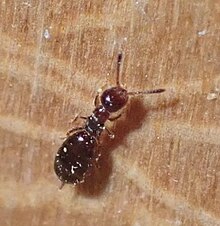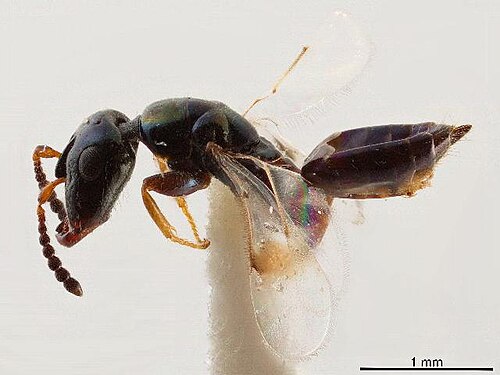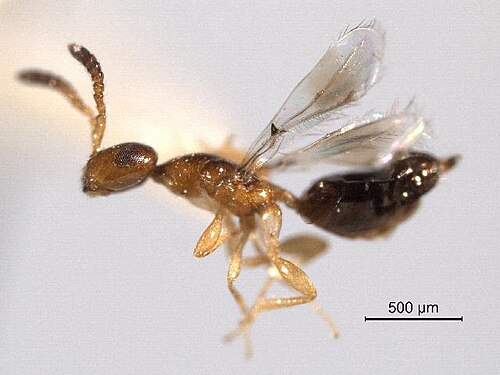
Fig wasps are wasps of the superfamily Chalcidoidea which spend their larval stage inside figs. Most are pollinators but others simply feed off the plant. The non-pollinators belong to several groups within the superfamily Chalcidoidea, while the pollinators are in the family Agaonidae. While pollinating fig wasps are gall-makers, the remaining types either make their own galls or usurp the galls of other fig wasps; reports of their being parasitoids are considered dubious.

Chalcid wasps are insects within the superfamily Chalcidoidea, part of the order Hymenoptera. The superfamily contains some 22,500 known species, and an estimated total diversity of more than 500,000 species, meaning the vast majority have yet to be discovered and described. The name "chalcid" is often confused with the name "chalcidid", though the latter refers strictly to one constituent family, the Chalcididae, rather than the superfamily as a whole; accordingly, most recent publications (e.g.,) use the name "chalcidoid" when referring to members of the superfamily.

The Pteromalidae are a large family of wasps, the majority being parasitoids of other insects. They are found throughout the world in virtually all habitats, and many are important as biological control agents. The oldest known fossil is known from the Early Cretaceous.

Eupelmidae is a family of parasitic wasps in the superfamily Chalcidoidea. The larvae of the majority are primary parasitoids, commonly on beetle larvae, though many other hosts are attacked, including spiders. Details of the life history varies considerably. They are found throughout the world in virtually all habitats.

The Ormyridae are a small family of parasitic wasps in the superfamily Chalcidoidea. They are either parasitoids or hyperparasitoids on gall-forming insects, primarily cynipid wasps and tephritid flies. The 120 or so species are cosmopolitan, except almost entirely absent from South America.
Trisecodes is a genus of parasitic chalcid wasps of the family Systasidae. The genus was originally placed in Eulophidae, based on a number of morphological features, but molecular evidence suggests that the genus is more closely related to Systasis and Semiotellus. The type species is a parasitoid of a range of Agromyzid leaf-mining flies.

Leptofoenus pittfieldae is an extinct species of wasp in the family Pteromalidae. It is known from early Miocene Burdigalian stage Dominican amber deposits on the island of Hispaniola. The species is known from a single 8.8 millimetres (0.35 in) male specimen excavated from the La Toca mine group northeast of Santiago de los Caballeros in 2008 and deposited in the Insect Fossil Collection at the University of Kansas Natural History Museum in Lawrence, Kansas, where it was studied and described by Dr. Michael S. Engel. The species name pittfieldae honors Ms. Morgan Pittfield, niece of the specimen donor.
Nasonia longicornis is a species of pteromalid wasp in the family Pteromalidae. It can be identified by the structure of its antennae. It is a parasitoid of Protocalliphora pupae, usually found in birds' nests. The species is found in western North America. Females usually only mate once in their lifetime.
Nasonia giraulti is a species of pteromalid wasp in the family Pteromalidae. It can be differentiated from other species in its genus by its antennae. The species can be found in eastern North America. It is a parasitoid of bird blow fly pupae.

Pirenidae is a family of chalcidoid wasps. It was formerly treated as a subfamily within the family Pteromalidae but is now recognized as a distinct family.
Eriaporinae is a subfamily of chalcid wasps in the order Hymenoptera, family Pirenidae. There are 2 genera and 6 described species in Eriaporinae.

Epichrysomallidae is a family of gall-forming wasps associated with fig trees - they make galls in figs, or on leaves or twigs. Once considered a subfamily of Pteromalidae (Epichrysomallinae), this group of genera has been elevated to family rank; they are now known to be more closely related to other gall-forming chalcid wasps than to pteromalids.

Diparidae is a family of chalcid wasps. This group was formerly treated as Diparinae, a subfamily of Pteromalidae.

Pelecinellidae is a small family of chalcidoid wasps, formerly treated as the subfamily Leptofoeninae within Pteromalidae. They, like many small chalcidoids, are brilliantly metallic.

Cleonymidae is a parasitic wasp family formerly treated as a subfamily within Pteromalidae.

Lyciscidae is a family of chalcid wasps. The genera comprising this family were previously placed in the Cleonyminae subfamily of a paraphyletic Pteromalidae.

Ceidae is a small family of chalcid wasps, previously classified as subfamily Ceinae, in the polyphyletic family Pteromalidae. These wasps are parasitoids of other small insects. Hosts are known only for Cea pulicaris and Spalangiopelta alata.

Chalcedectidae is a small family of chalcid wasps, previously classified as part of the subfamily Cleonyminae, in the polyphyletic family Pteromalidae. Most species are parasitoids of wood-boring beetles.
Neanastatidae is a family of chalcid wasps. The genera comprising this family were previously placed in the Neanastatinae subfamily of a paraphyletic Eupelmidae. They are parasitoids or hyperparasitoids of fly or beetle larvae.

Eunotidae is a family of chalcidoid wasps. In 2022, this family was described based on an analysis of a combination of molecular, morphological, and life history data.



















